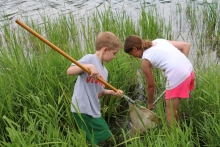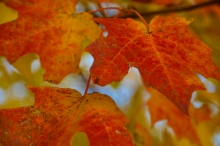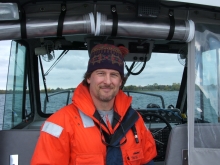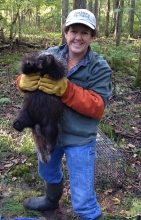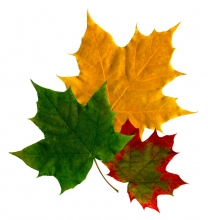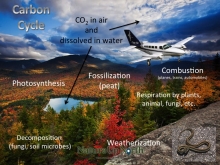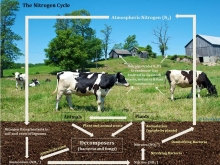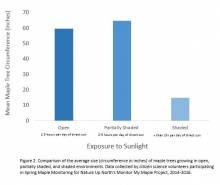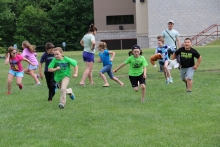What's Your Nature?
Become a Nature Up North explorer to share your encounters with wild things and wild places in New York's North Country. Post your wildlife sightings, landscape shots, photos from your outings, and even your organization's events!
Resources from Nature Up North
Place-based education is the process of using the local community and environment as a starting point to teach concepts in language arts, mathematics, social studies, science, and other subjects across the curriculum… Community vitality and environmental quality are improved through the active engagement of local citizens, community organizations, and environmental resources in the life of the school.
-David Sobel, Place-Based Education
Nature Up North works to be a resource for Northern New York teachers who wish to incorporate more place- and nature-based learning into their curriculum. One of our goals is to engage with K-12 teachers to promote hands-on outdoor lessons that improve learning outcomes, particularly in STEM subjects, while at the same time helping students connect with the natural world.
We are fortunate in the North Country to be surrounded by forests, wetlands, rivers, and farms that serve as excellent resources for bringing the classroom outdoors. Here, we offer lesson plans, activity guides, and other resources that encourage hands-on learning about the local environment.
Some of these resources, such as the “Interview with a Scientist” and the North Country nutrient cycle diagrams, offer place-based versions of lessons in the Common Core Curriculum. The Monitor My Maple Teacher Guide offers ways to engage students in hands-on citizen science projects, with examples for how to integrate project elements into science and math learning at various grade levels.
This page is new and expanding. Please check back soon for updates!
Did you know that the disruption of one simple species—such as aquatic insects—can disrupt an entire food web? This aquatic food web game depicts the necessity of all living organisms in the St. Lawrence River – from algae to great blue herons. Students will each be assigned a specific organism – bluegill, smallmouth bass, duck, frog, aquatic plants, and turtles to name a few. Each organism comes with a game tag that tells the kid what other organisms their organism eats and what eats it. Using yarn participants will become connected to each other based on their position in the food web. Once the web is complete, certain organisms will drop out to show that there is a ripple effect of organisms leaving the food web as a result of pollution, overfishing, or loss of food sources.
This game can be played on its own, but works especially well when paired with an aquatic macroinvertebrate hunt in which students have the opportunity to close examine algae, aquatic insects, amphibians, and other organisms on the low end of the food chain.
Grade level:
Resource Type:
Subject(s):
This worksheet walks students through one of 5 different citizen science projects, listed below. Assign students one of the projects listed to research, and instruct them to fill out the worksheet as they learn about the project. Students may work in groups or alone. This lesson is meant to be adaptable; different projects may be swapped in depending on your goals.
- Monitor My Maple (Nature Up North): natureupnorth.org/monitor-my-maple-project
- Water Monitoring (Nature Up North): natureupnorth.org/watermonitoring
- iNaturalist, California Academy of Sciences/National Geographic: inaturalist.org/
- eBird (Cornell Lab of Ornithology): ebird.org/home
- Nature’s Notebook (National Phenology Network): usanpn.org/natures_notebook
Grade level:
Resource Type:
Subject(s):
This is the complete data set from the fall maple monitoring citizen science project, updated August 1, 2017, in a .xlsx spreadsheet. The data set includes measurements on sugar and other maple species including circumference and indicators of health, local habitat, disease, etc. It also includes information on dates of leaf color change and leaf off. Feel free to use this data set with students for graphing or math exercises, to test hypotheses, or for mapping exercises. Let us know how you use the data, or if you'd like the data in a different format. If you wish to present or publish any results from these data, you must agree to acknowledge the Nature Up North Project at St. Lawrence University and North Country Citizen Scientists who collected the data.
Several excel files are available; the raw data, a cleaned file, and a cleaned file in which categorical data fields are coded numerically.
Grade level:
Resource Type:
Subject(s):
This data sheet provides a paper replica of the online Fall Monitor My Maple webform. Download and print to enable your students to record maple data in the field.
Grade level:
Resource Type:
Subject(s):
These resources were created for the high school Living Environment Ecology Unit. They feature examples of food chains and food webs featuring local species. Powerpoint slides have been included, so that you can use the arrow animations to highlight interactions between species. The notes for each slide include questions you might ask students, and incorporate some vocabulary terms from the unit.
Grade level:
Resource Type:
Subject(s):
This interview with Clarkson University limnologist Dr. Michael Twiss is available to use as an informational text in English Language Arts classes. Rather than interview a rainforest scientist, this interview is with a North Country scientist. Available as a pdf.
Grade level:
Resource Type:
Subject(s):
This interview with Wildlife Biologist Dr. Jorie Favreau is available to use as an informational text in English Language Arts classes. Rather than interview a rainforest scientist, this interview is with a North Country scientist. Available as a pdf.
Grade level:
Resource Type:
Subject(s):
This interview with North Country ecologist Dr. Erika Barthelmess is available to use as an informational text in English Language Arts classes. Rather than interview a rainforest scientist, this interview is with a North Country scientist. Available as a pdf.
Grade level:
Resource Type:
Subject(s):
This lesson serves as an introduction to Citizen Science, including a short reading and some activities and discussion points. The lesson uses Monitor My Maple as an example, but could easily be adapted for other citizen science projects.
- Reading: Citizen Scientists: Be a Part of Scientific Discovery from Your Own Backyard (Chapter One) by Loree Griffin Burns
- Full sciencenetlinks.com Citizen Science Lesson Guide: http://sciencenetlinks.com/lessons/citizen-scientists-be-part-scientific-discovery-your-own-backyard/
- Nature Up North Monitor My Maple Tutorial Video (www.natureupnorth.org/monitor-my-maple-project)
- Citizen Science Read-and-Report Worksheet
Grade level:
Resource Type:
Subject(s):
This lesson plan provides an introduction to phenology, including some hands-on activities and discussion points. The lesson uses Monitor My Maple as an example, but could easily be adapted for other citizen science projects.
Grade level:
Resource Type:
Subject(s):
This lesson plan and worksheet walks students through making observations about maple trees, developing a hypothesis, and analyzing their results by graphing.
Grade level:
Resource Type:
Subject(s):
This is a word-document version of the lab exercise Eniko Gilbert (Colton Pierrepont Central School) developed to extend on the Nature Up North Monitor My Maple citizen science project. We are posting it here with her permission. Feel free to contact her (gilberen@cpcs.us) with questions.
Grade level:
Resource Type:
Subject(s):
This guide gives information for teachers on how to incorporate the Nature Up North "Monitor My Maple" citizen science project into classroom activities. Not a lesson plan per se, the guide gives basic instruction on how to collect accurate measurements of maple trees and enter data for the project, and also gives suggestions of how to implment the project in classrooms for different ages of students.
Data sheets for both spring and fall Maple Monitoring are also available for download here.
Grade level:
Resource Type:
Subject(s):
This Teacher's guide is a how-to guide for including the Monitor My Maple project in a high-school science curriculum. The guide walks you through the steps of using the Monitor My Maple project in your classroom, and includes the associated next generation science standards, a curriculum outline for both fall and spring, and a procedure guide.
Guide produced by SLU Alum Madison O'Shea ('19)
Grade level:
Resource Type:
Subject(s):
This unit calendar is an example of how you might organize various lessons for teaching a unit on Monitor My Maple. Relevant standards are highlighted for each lesson. Please note that Lessons 1,2,3, 8, and 11 (shaded blue on the calendar) have been developed and are available for use via the Educator Resources page. Others are included as suggestions for what you may develop and may be added in time and/or with your assistance. Feedback is welcome and encouraged.
Grade level:
Resource Type:
Subject(s):
This is a teacher's guide for the Monitor My Maple project. It includes examples of standards, clear instructions for starting the project, and FAQ's.
Grade level:
Resource Type:
Subject(s):
This word document presents a series of questions that ask the user to find and use different aspects of the Nature Up North website in order to become familiar with the website's features.
Grade level:
Resource Type:
Subject(s):
This diagram illustrates the carbon cycle in a north country context. Rather than use the stereotypical textbook image, this image includes carbon reservoirs that we see here in the North Country as well as relevant ways in which carbon is moved through the cycle. Available as a jpg image or a powerpoint slide.
Grade level:
Resource Type:
Subject(s):
This diagram illustrates the nitrogen cycle in a north country context (on a dairy farm). Rather than use the stereotypical textbook image, this image includes carbon reservoirs that we see here in the North Country as well as relevant ways in which carbon is moved through the cycle. Available as a jpg image and as a Powerpoint slide, so that you may edit and insert animated arrows to demonstrate nutrient flow through the cycle.
Grade level:
Resource Type:
Subject(s):
This is a java program to install locally on your computer. It will package all of your game camera pictures into a single zipped folder to then transfer to the Nature Up North file repository. The program works on both Windows and Mac operating systems.
Grade level:
Resource Type:
Subject(s):
This activity is a relay race where student learn about phenology by matching pictures of seasonal change with the season they belong to. Several example cards are included, but more would need to be created depending on the season(s) you would like to teach about.
Grade level:
Resource Type:
Subject(s):
This is the complete data set from the spring maple monitoring citizen science project, updated August 1, 2017, in a .xlsx spreadsheet. The data set includes measurements on sugar and other maple species including circumference and indicators of health, local habitat, disease, etc. It also includes information on dates of bud break, leaf emergence, and flowering. Feel free to use this data set with students for graphing or math exercises, to test hypotheses, or for mapping exercises. Let us know how you use the data, or if you'd like the data in a different format. If you wish to present or publish any results from these data, you must agree to acknowledge the Nature Up North Project at St. Lawrence University and North Country Citizen Scientists who collected the data.
Several excel files are available; the raw data, a cleaned file, and a cleaned file in which categorical data fields are coded numerically.
Grade level:
Resource Type:
Subject(s):
This figure compares the average circumference of maple trees found growing in different habitats such as school lawns, school gardens, home lawns, and in natural settings. Data shown here includes spring data on sugar and other maple trees, collected primarily by North Country K-12 students participating in Monitor My Maple from 2014-2016. The figure is available as a .pdf file, feel free to use this data as an example in classroom lessons, for math exercises, or whatever you can think of. Let us know how you use it, and what other results you're interested in seeing or if you'd like to the data exported in a different fomat.
Grade level:
Resource Type:
Subject(s):
This figure compares the average size (circumference) of maple trees found growing in open, partially shaded, and shaded in evironments. Data shown here includes spring data on sugar and other maple trees species, collected primarily by North Country K-12 students participating in Monitor My Maple from 2014-2016. The figure, available as a .pdf file, is available for use as an example in classroom lessons, for math exercises, or whatever you can think of. Let us know how you use it, and what other results you're interested in seeing or if you'd like to the data exported in a different fomat.
Grade level:
Resource Type:
Subject(s):
The Squirrel Game provides an interactive way for students to learn about small mammal ecology and predator-prey relationships. The idea is that red and gray squirrels have different food caching strategies, but both must avoid predators in order to survive. The goals of this program are to help students understand differences in behavior between red and gray squirrels, teach students about the diets of red and grey squirrels, help students understand predator-prey interactions, and to make outdoor play fun. These goals are accomplished by engaging the students in a tag-like game where they become the red and gray squirrels and have to store their food for the winter while simultaneously avoiding predators like foxes, owls, and coyotes. This game was adapted from a program developed by Shelburne Farms.

